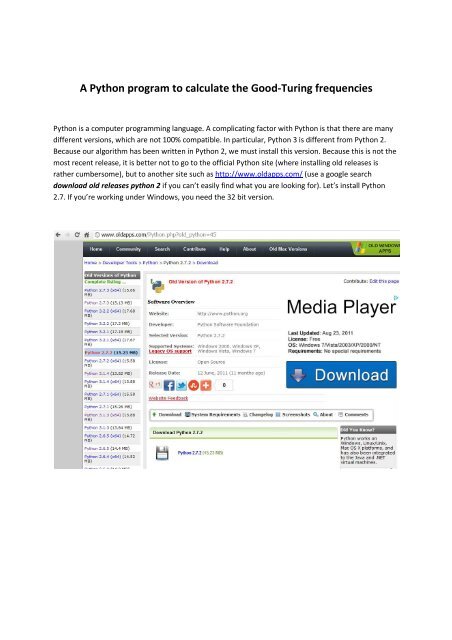A Python program to calculate the Good-Turing frequencies
A Python program to calculate the Good-Turing frequencies
A Python program to calculate the Good-Turing frequencies
Create successful ePaper yourself
Turn your PDF publications into a flip-book with our unique Google optimized e-Paper software.
You can now open <strong>the</strong> <strong>Python</strong> shell using Programs under <strong>the</strong> Windows Start but<strong>to</strong>n.
Write import numpy and enter; write import scipy and enter
Go <strong>to</strong> your <strong>Python</strong> Shell and open <strong>the</strong> file sgtInp.py from <strong>the</strong> direc<strong>to</strong>ry in which you saved it.
Click on Run:Input <strong>the</strong> required data <strong>to</strong> get <strong>the</strong> outputfile:
Open <strong>the</strong> file <strong>to</strong>yCounts_SGT.txt <strong>to</strong> see <strong>the</strong> output. In this file you get <strong>the</strong> output both as raw counts andas <strong>frequencies</strong> per million. So, <strong>the</strong> zero mass is 34/50 or 680,000 pm. The words observed once (or20,000 pm) get a re<strong>calculate</strong>d frequency of .26/50 or 5,219 pm. The words observed twice have a newfrequency of .83/50 or 16,534 pm. Finally, <strong>the</strong> words observed three times have a new frequency of1.50/50 or 29,942 pm.You get <strong>the</strong> same information if you run <strong>the</strong> <strong>to</strong>ySpec.txt file:
You find <strong>the</strong> information in <strong>the</strong> <strong>to</strong>ySpec_SGT.txt file now arranged as a frequency spectrum (adistribution of <strong>the</strong> different frequency values).
















